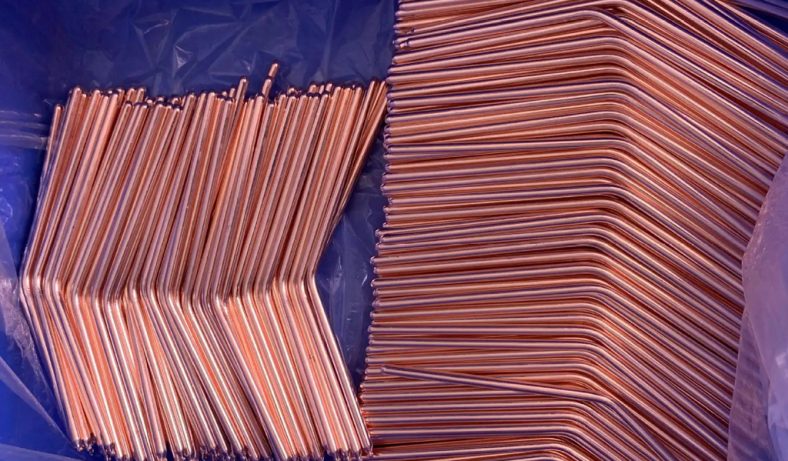
The Define Of Copper Cpu Heatsink
The thermal conductivity of copper is 1.69 times that of aluminum, so all other things being equal, a pure copper heat sink will be able to remove heat from the heat source faster. However, the texture of copper is a problem. Many advertised “pure copper radiators” are not really 100% copper. In the list of copper, copper with a copper content of more than 99% is called acid-free copper, and the next grade of copper is Dan copper with a copper content of less than 85%.
Most of the pure copper heat sinks on the market for 2013 have a copper content between the two. The copper content of some inferior pure copper radiators is not even 85%. Although the cost is very low, its thermal conductivity is greatly reduced, which affects the heat dissipation. In addition, copper also has obvious shortcomings, high cost, difficult processing, and too large heat sink quality hinder the application of all-copper heat sinks; the hardness of red copper is not as good as that of aluminum alloy AL6063, and the performance of some machining (such as grooves, etc.) is not as good as aluminum. ; The melting point of copper is much higher than that of aluminum, which is not conducive to extrusion and other problems.
Copper-Aluminum Bonding Technology
After considering the respective shortcomings of copper and aluminum, some high-end heat sinks in the market often use copper and aluminum combined manufacturing processes. These heat sinks usually use copper metal bases, while heat sink fins are made of aluminum alloy. Of course, in addition to the copper bottom, there are also methods such as the use of copper pillars for the heat sink, which is also the same principle. With high thermal conductivity, the copper bottom surface can quickly absorb the heat released by the CPU; the aluminum fins can be made into the most favorable shape for heat dissipation by means of complex processes, and provide a large heat storage space and release it quickly. A balance has been found in all aspects.
Heat is dissipated from the CPU core to the surface of the heat sink, which is a heat conduction process. For the base of the heat sink, since it is in direct contact with a small area of high heat source, it is required that the base can quickly conduct heat away. The use of materials with higher thermal conductivity for the heat sink is very helpful to improve the thermal conductivity. It can be seen from the comparison table of heat conduction system that, for example, the thermal conductivity of aluminum is 237W/mK, and the thermal conductivity of copper is 401W/mK. Comparing heatsinks of the same volume, the weight of copper is 3 times that of aluminum, while the specific heat of aluminum is 3 times. It is only 2.3 times that of copper, so under the same volume, a copper heatsink can hold more heat than an aluminum heatsink and heat up more slowly. With the same thickness of the heat sink base, copper can not only quickly remove the temperature of heat sources such as CPU Die, but also its own temperature rise is slower than that of aluminum heat sinks. Therefore, copper is more suitable for making the bottom surface of the heat sink.
However, the combination of these two metals is relatively difficult, and the affinity between copper and aluminum is poor. thermal resistance). In actual design and manufacturing, manufacturers always try to reduce the interface thermal resistance as much as possible and avoid weaknesses, which often reflects the manufacturer’s design capabilities and manufacturing processes.
Common copper-aluminum bonding processes include:
Knee Welding
Knee welding is to use a metal material with a melting point lower than that of the base metal as the solder. At a temperature lower than the melting point of the base material but higher than the melting point of the solder, the liquid solder is used to wet the base material, fill the joint gap, and then condense to form a firm joint interface. Welding method. The main processes are: material pretreatment, assembly, heating welding, cooling, post-processing, etc. The commonly used stick welding method is tin stick welding. The aluminum surface will form a very stable oxide layer (AL2O3) in the air, which makes copper-aluminum welding difficult, which is the biggest factor hindering welding. It must be removed or chemically removed and plated with a layer of nickel or other easily solderable metal so that the copper and aluminum can be smoothly welded together.
The copper bottom on the heat sink is for heat conduction, which requires not only mechanical strength, but also a large welding area (high welding rate), in order to effectively improve the heat dissipation efficiency, otherwise it will not improve the heat dissipation efficiency, Instead, it will make it worse than an all-aluminum heatsink.
Patch, Screw Locking
The patch process is to combine the thin copper sheet with the aluminum bottom surface through screws. The main purpose of this is to increase the instantaneous heat absorption capacity of the heatsink and prolong the life cycle of some pure aluminum heatsinks with mature design. After testing, it was found that: using a high-performance heat-conducting medium between the bottom of the aluminum heat sink and the copper block, applying a force of 80Kgf and then locking it with screws, the heat dissipation effect is equivalent to that of copper-aluminum welding, and it also achieves the expected The cooling performance is improved.
This method is simpler than welding, and the quality is stable, the process is simple, and the cost of input equipment is lower than that of welding, but it is only an improvement, so the performance improvement is not obvious. Although filled with thermal paste, the incomplete contact between the copper sheet and the aluminum base is still the biggest obstacle to heat transfer.
The main manufacturing processes are: copper sheet cutting, leveling (flatness less than 0.1mm, drilling, applying thermal medium to drilling, tapping, cleaning, strong preloading procedure, two-stage locking operation, fixed torque locking screw.
The focus of the patch process is to control the flatness and roughness of copper, aluminum, and the torque of the locking screw, which can improve the efficiency to a certain extent. It is a good way of combining copper and aluminum. If the performance of the heat transfer medium used is poor, or the flatness of the copper block is poor, the heat cannot be smoothly conducted to the surface of the aluminum heat sink, which greatly reduces the heat dissipation effect. In addition, the locking force of the screw and the purity of the copper material are not enough, which are all bad influencing factors.
Plug Copper Embedded Copper
There are two main ways to plug copper. One is to embed the copper sheet into the aluminum base plate, which is commonly used in the heat sink manufactured by the aluminum extrusion process. Due to the limited thickness of the bottom of the aluminum heat sink, the volume of embedded copper sheets is also limited. The main purpose of adding copper sheets is to enhance the instantaneous heat absorption capacity of the heatsink, and the contact with the aluminum heatsink is also very limited, so in most cases, the effect of this copper-aluminum heatsink is not much better than that of the aluminum heatsink. , in the case of poor contact, it will even hinder heat dissipation. Another is to embed copper pillars in aluminum heat sinks with radial fins. Intel’s original heatsink uses such a design. The volume of the copper column is larger and the contact with the heat sink is sufficient. After the copper pillar is used, the heat capacity and instantaneous heat absorption capability of the heat sink can be enhanced. This design is also used more by OEMs.
The copper plugging process is generally implemented in the following ways:
Mechanical Pressing
The mechanical pressing method is to press a piece of copper with a diameter larger than the diameter of the aluminum aperture and press them together mechanically. Because aluminum is ductile, copper can be combined with aluminum heat sinks at room temperature. The effect of the combination of methods is also quite impressive, but there is a fatal disadvantage that when the copper is extruded into the aluminum hole, the inner surface of the aluminum hole is easily scratched by the copper, which seriously affects the heat conduction. This is to avoid such problems by reasonably matching the interference and optimizing the shape of the copper block.
Thermal Expansion And Cold Contraction
A circular hole with a diameter of ψ=D1 is processed at the bottom of the aluminum heat sink, and a copper column with a diameter of ψ=D1+0.1MM is made. Using the thermal expansion and contraction characteristics of the metal material, the aluminum heat sink is heated to 400 ℃. The diameter of its thermal expansion circular hole expands to more than D1+0.2MM. A special machine is used to quickly insert the normal temperature (or cooled) copper column into the circular hole of the aluminum heat sink at high temperature. After it cools and shrinks, the copper column and the aluminum heat sink can be tightly integrated into one. It is also a reliable method with high copper-aluminum stability and optimum bond tightness since no third-party media is used. The copper plugging process can greatly reduce the thermal resistance between the contact surfaces, which not only ensures the tightness of the copper-aluminum bond, but also makes full use of the heat dissipation characteristics of the two metal materials.
But pay attention to the quality control of the diameter and surface roughness of the copper pillars and holes, which will have a certain impact on the heat dissipation effect.
After the copper plugging process, the bottom surface of the heatsink is often “milled” and “grinded”. The milling process is aimed at the copper core in the plugging process, and the grinding process is aimed at smoothing the bottom of the entire heat sink.




